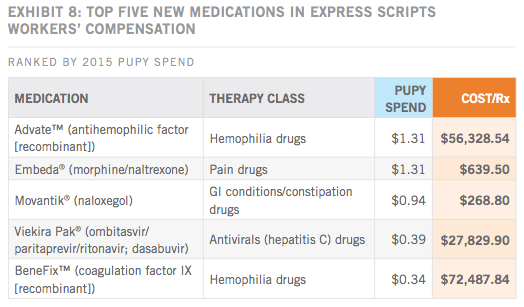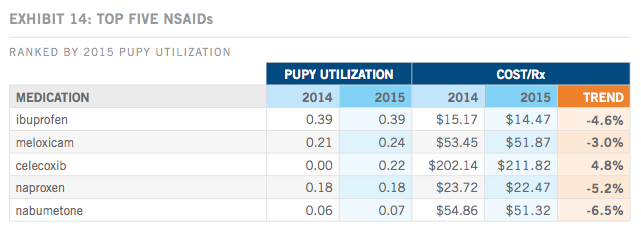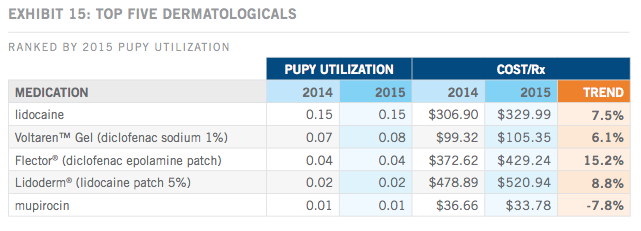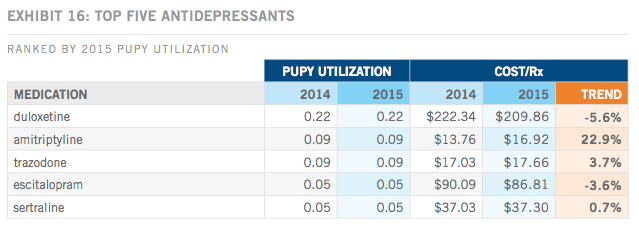Article
Top 5 Workers' Comp Drug Classes
Author(s):
Workers' compensation drug spending per worker increased only 2.2% last year as a result of utilization decreasing 2.6%, which offset the 4.4% increase in average cost per prescription.
Workers’ compensation drug spending per worker increased only 2.2% last year as a result of utilization decreasing 2.6%, which offset the 4.4% increase in average cost per prescription.
Express Scripts, the largest pharmacy benefits manager (PBM) in the United States and a manager of workers’ compensation prescriptions in all 50 states, revealed in its 2015 Workers’ Compensation Drug Trend Report that the overall drug trend for its clients was 2.2%.
Notably, 6 of the top 10 medication classes by spending saw negative trends. Spending on compounded medications, for example, decreased 33.7%.
“The impact of new medications on costs was minimal [for payers] in 2015, as only a few medications with significant costs were brought to market in late 2014 and 2015,” Express Scripts said in the report. “Harvoni, a specialty antiviral medication used to treat hepatitis C, was one of these few high-cost medications, but low use of these medications among injured workers minimized the effect on trend.”
Express Scripts said new products, such as the ones listed below, generally aren’t included on its workers’ compensation formularies unless specifically requested by its clients.

The PBM’s “Prescription Price Index” showed that brand-name drug prices were 16.2% higher in 2015 compared with prices in 2014.
Here are the top 5 drug classes dispensed to workers’ compensation beneficiaries, ranked by per-user-per-year (PUPY) costs.
1. Opioids
The PUPY cost for opioid prescriptions was $450.90 in 2015, which represents a 4.9% decrease from 2014.
Opioids have consistently held their place as both the most expensive and highly utilized medication class for work-related injuries. In fact, 9 of the top 25 workers’ compensation medications dispensed overall in 2015 were opioids.
“Workers’ compensation formularies are developed with clinical appropriateness and association with workplace injuries in mind—injuries that are often accompanied by acute or chronic pain,” Express Scripts wrote.
Of note, 34.6% of all workers’ compensation opioid prescriptions written in 2015 were for hydrocodone/acetaminophen, which was rescheduled as a Schedule II controlled substance on October 6, 2014.
About 2% of opioid prescriptions filled by injured workers in 2015 were for abuse-deterrent formulations of the pain drugs.

With the exception of Oxycontin and Oxaydo, all opioids increased in both utilization and cost in 2015. Chronic pain leads to an estimated $60 billion in lost productivity each year.
2. Anticonvulsants
The PUPY cost for anticonvulsant prescriptions was $170.51 in 2015, which is an 11.3% increase from 2014.

The top 5 medications by utilization accounted for 77% of total anticonvulsant medications in 2015 for injured workers, with gabapentin and Lyrica accounting for 79.6% of utilization in this therapeutic category.
Although Trokendi XR, a long-acting form of topiramate, doesn’t appear in the top 5 list, Express Scripts noted that it saw an increase in spending of 167%, comprised of a 94.7% increase in utilization and 37.1% increase in cost per prescription.
“The clinical rationale for prescribing this medication for most workers’ compensation pain conditions is uncertain,” the report said. “Generic topiramate is available.”
Express Scripts noted in its report that use of more expensive brand-name drugs can happen because injured workers may request to receive them over generic versions.
3. Nonsteroidal Anti-Inflammatory Drugs (NSAIDs)
The PUPY cost for NSAID prescriptions was $141.41 in 2015, which is an 8.7% decrease from 2014.
According to Express Scripts’ data, NSAIDs are the second-most utilized medication class for work-related injuries. Beneficiaries are able to use either oral or topical formulations.

Generic versions of Celebrex (celecoxib), which launched in December 2014, ranks fourth on the list of top 25 workers’ compensation medications by PUPY spend. Celecoxib is the only product on the list of top 5 NSAIDs that increased in trend.
The average cost per workers’ compensation prescription for NSAIDs was $102.01
4. Dermatologicals
The PUPY cost for dermatologicals was $112.99 in 2015, which is an 11.7% increase from 2014. This increase was mainly driven by a 15.8% increase in the average cost per prescription, which Express Scripts data shows was $288.42 for 2015.
Notably, brand-name Lidoderm (lidocaine patch 5%) saw an 8.8% increase in cost per prescription between 2014 and 2015, despite several generic versions coming to the marketplace in 2015. This suggests that workers’ compensation beneficiaries are requesting the brand name despite the availability of generics.

Meanwhile, PMPY spending for skin condition medications was just $20.15 in 2015 for the PBM’s members who weren’t using the workplace compensation formulary.
5. Antidepressants
The PUPY cost for antidepressants was $98.23 in 2015, which is a 3% decrease from 2014.
The average number of PUPY prescriptions in this class is 0.81, while the average cost per prescription is $120.83.

Of note, amitriptyline, the second-most utilized medication in this class, saw a 22.1% PUPY trend, which Express Scripts contributed to a 22.9% increase in cost per prescription.
Brand-name Cymbalta (duloxetine) lost patent protection in December 2013, and the FDA approved more than a half-dozen generic versions throughout 2014.
Duloxetine, which is indicated to treat depression, anxiety, fibromyalgia, chronic musculoskeletal pain and neuropathic pain, replaced Cymbalta as the class leader for PUPY spend in 2015.
“Although generics dominate the medications in this class, Wellbutrin XL (bupropion extended release), the second ranked by PUPY spend, had a 77% trend, reflecting a $111 increase in average cost per prescription,” Express Scripts observed.





